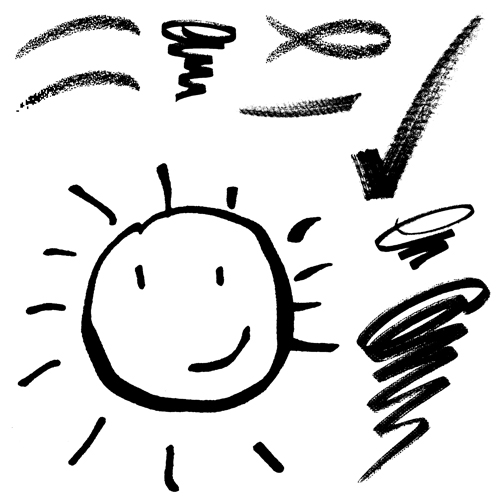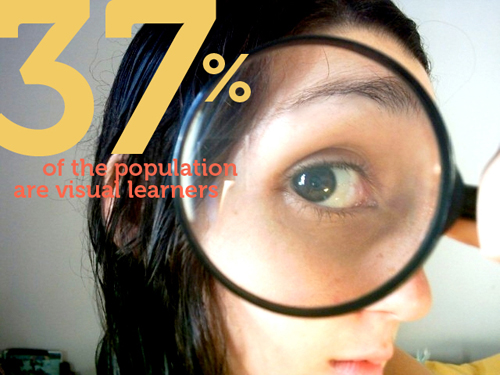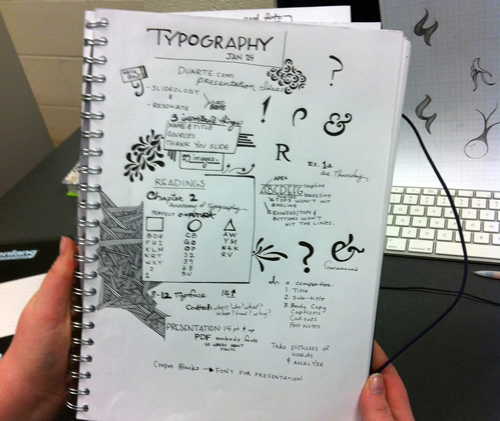Drawing Pictures All Day
“I draw pictures all day.” “So, you do nothing all day?”
That’s how many people would respond to someone who says they spend the day with a pen or pencil in their hand. It’s often considered an empty practice, a waste of time. They’re seen as an empty mind puttering along with the busy work of scribbling.
But for us designers and artists, drawing pictures all day is integral to our process and to who we are as creative people, and despite the idea that those who doodle waste time, we still get our work done. So, then, why are those of us who draw pictures all day even tempted to think that someone who is doodling or drawing pictures in a meeting or lecture is not paying attention?
What Does It Mean To Doodle?
The dictionary defines “doodle” as a verb (“scribble absentmindedly”) and as a noun (“a rough drawing made absentmindedly”). It also offers the origins of the word “doodler” as “a noun denoting a fool, later as a verb in the sense ‘make a fool of, cheat.’”
But the author Sunni Brown offers my favorite definition of “doodle” in her TED talk, “Doodlers, unite!”:
“In the 17th century, a doodle was a simpleton or a fool, as in “Yankee Doodle.” In the 18th century, it became a verb, and it meant to swindle or ridicule or to make fun of someone. In the 19th century, it was a corrupt politician. And today, we have what is perhaps our most offensive definition, at least to me, which is the following: “To doodle officially means to dawdle, to dilly dally, to monkey around, to make meaningless marks, to do something of little value, substance or import and,” my personal favorite, “to do nothing.” No wonder people are averse to doodling at work. Doing nothing at work is akin to masturbating at work. It’s totally inappropriate.”
It is no wonder, then, why most people do not have great expectations of those who “draw pictures all day.” Or perhaps they are inclined to think that those who draw pictures all day are not highly intellectual and are tempted to say to them condescendingly, “Go and draw some of your pictures.” As designers, many of us have heard such comments, or at least felt them implied, simply because we think, express or do things differently.
Why Do We Doodle?
Consider that even before a child can speak, they can draw pictures. It is part of their process of understanding what’s around them. They draw not just what they see, but how they view the world. The drawing or doodle of a child is not necessarily an attempt to reflect reality, but rather an attempt to communicate their understanding of it. This is no surprise because playing, trial and error, is a child’s primary method of learning. A child is not concerned with the impressions that others get based on their drawings or mistakes.

Their constant drawing, picture-making and doodling is a child’s way of expressing their ideas and showing their perceptions in visual form. It comes from a need to give physical form to one’s thoughts. Similarly, an adult doodles in order to visualize the ideas in their head so that they can interact with those ideas.
Visual Learners
According to Linda Silverman, director of both the Institute for the Study of Advanced Development and the Gifted Development Center and author of Upside-Down Brilliance: The Visual-Spatial Learner, 37% of the population are visual learners. If so many people learn better visually, we can expect, then, that some of them learn better by putting a speech, lecture or meeting into visual and tangible form through pictures or doodles, rather than by being provided with pictures or doodles (which would be the product of another person’s mind).

Humans have always had a desire to visually represent what’s in their minds and memory and to communicate those ideas with others. Early cave paintings were a means of interacting with others, allowing an idea or mental image to move from one person’s mind to another’s. The purpose of visual language has always been to communicate ideas to others.
Secondly, we doodle because our brain is designed to empathize with the world around us. According to Carol Jeffers, professor at California State University, our brains are wired to respond to, interact with, imitate and mirror behavior. In an article she wrote, she explains the recent research into “mirror neurons” which help us understand and empathize with the world around us.

Think of it this way. When you’re at an art gallery and find a painting that intrigues you, what is your first reaction? You want to touch it, don’t you? I thought so.
When I was a ballroom dancer, I used to sit and watch those who I considered to be great dancers, tracing their forms in space with my index finger as a way to commit them to memory. I used to go to galleries and museums and, at a distance, trace the lines and forms that I saw in the paintings and designs. I did this out of curiosity and a desire to physically record what I saw to memory.
Nearly 100 years ago, Maria Montessori discovered the link between physical touch and movement and learning in children. Montessori education teaches children to trace the letters of the alphabet with their index finger as a way to commit their shapes to memory. My son used to trace forms that he found interesting in space. It’s safe to say, then, that we doodle to visually commit to memory a concept that we want to both empathize and interact with.
An experiment conducted by Jackie Andrade, professor of psychology at the University of Plymouth in England, demonstrated the positive effect that doodling has on memory retention. In the experiment, 40 people were given a simple set of instructions to take RSVP information over the phone from people going to a party. The group of 40 was divided in two. One group of 20 was told to doodle (limited to shading in order not to emphasize the quality of the doodles), and the other 20 would not doodle.
The doodlers recalled 29% more information.
The study showed that doodling helps the brain to focus. It keeps the mind from wandering away from whatever is happening, whether it’s a lecture, reading or conference talk.
Still, we have become bored with learning.
Professor Emeritus at Cornell University, Joseph D. Novak argues that this is because we have been taught to memorize but not to evaluate the information being given to us. In many traditional settings, the pattern is simple and dull: sit, receive and memorize. Many traditional educational systems do not encourage active engagement with the material. Doodling, drawing and even making diagrams helps us not only engage with the material, but also identify the underlying structure of the argument, while also connecting concepts in a tactile and visual way. Jesse Berg, president of The Visual Leap, pointed out to me in a conversation that doodling is a multisensory activity. While our hand is creating what might seem to be random pictures, our brain is processing the stimuli that’s running through it.
Many of us are the product of traditional schooling, in which we were made to numbingly memorize dates and facts, and many of us continue this pattern later in life. While some of us were avid doodlers (I used to fill the backs of my notebooks with pictures and draw on desks with a pencil during class), some of us stopped at high school, others in college and others once we settled into a job. At some point during the education process, doodling was discouraged. Teachers most likely viewed it as a sign of inattentiveness and disrespect. After hard preparation, educators want nothing more than unwavering attention to their lectures. The irony is that, according to Andrade’s study, doodlers pay more attention to the words of educators than we think.
In her TED talk, Sunny Brown goes on to explain the benefits of doodling and even offers an alternative to the definition found in the Oxford Dictionary:
“Doodling is really to make spontaneous marks to help yourself think. That is why millions of people doodle. Here’s another interesting truth about the doodle: People who doodle when they’re exposed to verbal information retain more of that information than their non-doodling counterparts. We think doodling is something you do when you lose focus, but in reality, it is a preemptive measure to stop you from losing focus. Additionally, it has a profound effect on creative problem-solving and deep information processing.”
How Can Designers Use This To Their Benefit?
As designers, we have a unique advantage when it comes to doodling. We don’t just doodle to keep our minds focused — we also deliberately sketch ideas in order to problem solve and to get immediate feedback from clients and peers. Designers such as Craighton Berman and Eva-Lotta Lamm are two of the biggest proponents of the “sketchnotating” movement. Berman states that sketchnotating “forces you to listen to the lecture, synthesize what’s being expressed, and visualize a composition that captures the idea — all in real time.”
In 2009, I came across a book titled The Back of the Napkin by Dan Roam. Roam is a business strategist and founder of Digital Roam, a management-consulting firm that uses visual thinking to solve complex problems. He uses a simple approach to solving problems visually. Every idea is run through five basic questions to encourage engaged thinking and to ensure a meaningful meeting. The process takes the acronym SQVI^. S is for simple or elaborate, Q is for qualitative or quantitative, V is for vision or execution, I is for individual or comparison, and ^ is for change or status quo. These simple choices are worked through with simple doodles in order to better understand the problem and find a solution. In his book, Roam says:
“What if there was a way to more quickly look at problems, more intuitively understand them, more confidently address them, and more rapidly convey to others what we’ve discovered? What if there was a way to make business problem solving more efficient, more effective, and — as much as I hate to say it — perhaps even more fun? There is. It’s called visual thinking, and it’s what this book is all about: solving problems with pictures.”
After discovering Roam’s book, I decided to doodle again. Once a prolific doodler and drawer, I had become inactive in lectures and similar settings, often forgetting what was said. Taking notes felt too cumbersome, and I often missed words and ideas. I decided to give doodling another shot. Instead of focusing on specifics, I would focus on concepts, key words and ideas.
Since 2011, I have been actively promoting doodling in my design classes, making a deal with my students, saying to them, “Doodle to your heart’s content, but in return I want you to doodle the content of my lectures.” They are skeptical at first, but they soon realize that doodling is better than having a quiz. I reap the benefits of doodling, and by allowing them to doodle — with the requirement that it be based on the class’ content — they become more informed of the topic and they engage in more meaningful conversations about design.

The typographic novices in my classes naturally start to apply the principles of visual hierarchy and organization, grouping ideas either by importance or by category. They will group ideas with lines, boxes, marks and more. Headings and lecture titles might be made larger, more ornate or bolder, and key concepts might be visually punctuated. It is fascinating how natural and almost second-nature the idea of visual hierarchy is to all of us. The learning curve of typography is steep for some of us, but doodling and sketchnotating really makes it easier to grasp. Below are some doodles by students in my classes.

By picking out concepts, ideas and topics, the students start to establish a hierarchy by making visual groupings and start to use visual punctuation. By the time I assign work on typographic hierarchy, the sketches tend to show more astuteness. Transferring these sketches to the computer is a challenge for those new to typography, but once they naturally understand the relationships in what they are doing, they start to make smarter design decisions.


As we have seen, doodling has many benefits, beyond what designers as visual communicators and problem solvers use it for. Doodling also helps our brain function and process data. Those of us who doodle should do so without feeling guilty or ashamed. We are in good company. Historically, doodlers have included presidents, business moguls and accomplished writers. Designer, educator and speaker Jason Santa Maria says this:
“Sketchbooks are not about being a good artist. They’re about being a good thinker.”
Doodling, drawing pictures and sketchnotating are about using visual skills to solve problems, to understand our world and to respond effectively. So, what are you waiting for? Doodle!
Further Resources
- “Sketchnotes 101: The Basics of Visual Note-Taking,” Craighton Berman, Core77
- “Why Graphic Designers Should Learn to Draw,” Douglas Bonneville, BonFX
- “Get Smart: Doodle!,” TimTim
- “Sketchnotes and Visual Note-Taking,” Eva-Lotta Lam, SlideShare The slides are from Lam’s talk at WebExpo Prague 2010.
- “Sketch, Sketch, Sketch,” Joshua Brewer, 52 Weeks of UX
- “Idle Doodles by Famous Authors,” Emily Temple, FlavorWire
Unless otherwise stated, images are from Stock.XCHNG.
Further Reading
- Hand-Sketching: Things You Didn’t Know Your Doodles Could Accomplish
- How To Get Started With Sketchnotes
- 50 Clever Tutorials and Techniques on Traditional Drawing
- To Sketch or Not to Sketch – That is the Question



 RSVP HERE
RSVP HERE
 Flexible CMS. Headless & API 1st
Flexible CMS. Headless & API 1st



